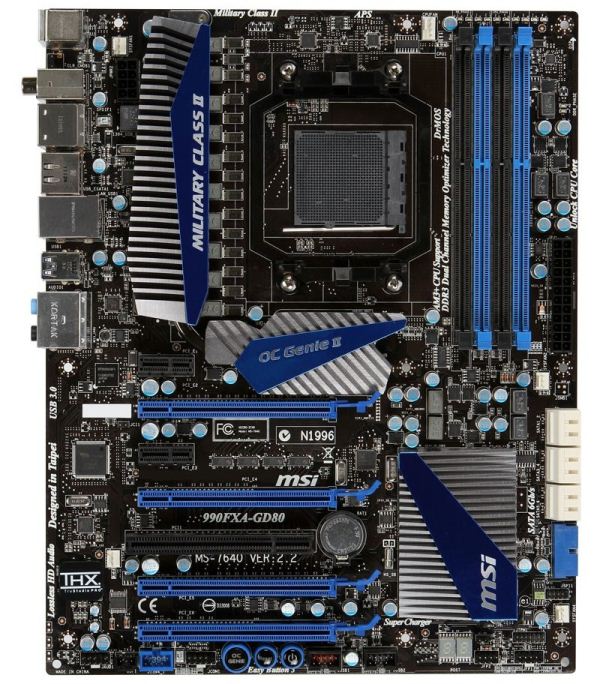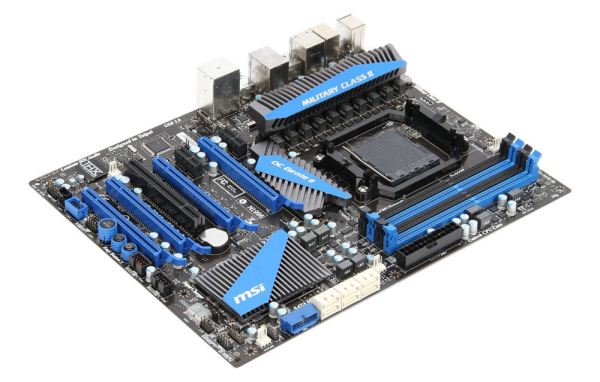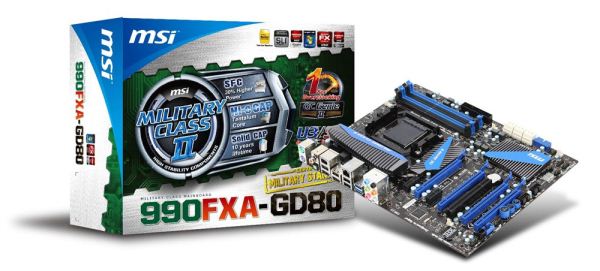990FX Motherboard Roundup with Thuban and Bulldozer – A Second Wind for ASUS, Gigabyte, MSI and Biostar
by Ian Cutress on April 5, 2012 11:00 AM ESTMSI 990FXA-GD80
Where the ASUS channel boards are called the LE, the standard, the Pro, and the Deluxe, Gigabyte has the UD3, UD4/H, UD5, UD7, UD9, and ASRock has Extreme3, Extreme4, Extreme6, Extreme7 and Extreme9. For MSI, this rears itself as a set of numbers preceded by the letters G or GD: we have the 80, 65, 55, 45, and 43, amongst others.
Channel boards are very important to all these manufacturers – they represent the bulk of consumer level sales whereas the gaming / overclocking / stability products are purely for niche environments. In most cases, the home user will only need a channel board, either at the high, medium or low end depending on need. So here we have the MSI 990FXA-GD80, which represents MSI’s higher end ‘mainstream’ offering.
The board itself currently e-tails for $195, slightly more than the ASUS Sabertooth 990FX and the Gigabyte 990FXA-UD5 in this combination review, but should offer a good comparison point. As it is up to $15 more than the Gigabyte, I hope that we can pin down where the $15 goes.
Overview
As a manufacturer, MSI has come up with some good products in their time (e.g. X79 Big Bang XPower II), and some that made me turn around and wonder ‘why?’ (e.g. the BIOS on the P67A-GD65). With our first look at some MSI AMD action in a fair while, I can say that while the 990FXA-GD80 is a nice board to work with, it is perhaps not the feature packed product to cover certain market areas. Do not get me wrong, MSI has some strong areas such as what comes In The Box with the board, however certain features like their fan header placement are not exactly optimal.
Performance wise, the MSI 990FXA-GD80 is no slouch, roughing it toe-to-toe with the other products we have in this review. Features such as the OC Genie, Power/Reset Buttons and a USB 3.0 header at right angles to the board are to be well received. The heatsink design and shape fits in well with the products image (despite the Military Class II paraphernalia obligatorily pasted across it), and the onboard PCIe layout has some thought behind it.
Users will note that different BIOS versions have different BIOS screens. If you update this beyond BIOS B5, the system will display the new graphical BIOS which MSI is very proud about (and it works rather well). However on startup, the board caused my AMD graphics cards (note, 5850s) to spin at 100% for several seconds. Somewhat odd behavior – the cards did not do this in other boards, and neither did our NVIDIA testing cards.
For overclocking, under Thuban the 990FXA-GD80 performed well giving respectable numbers. However while using the Bulldozer processor we were severely limited in terms of voltages and base frequency adjustments, limiting the range to which the overclocks can be performed. More on this is detailed in the Overclocking section.
This board, at $195, performs well for its money compared to other boards in its bracket, and with some bonuses in the box, would fit well into a 990FX system. With a few minor modifications/suggestions, this could have been the ultimate 990FX product, but nonetheless, I can see a lot of people using this board and enjoying it.
Visual Inspection
In keeping with MSI’s mainstream color scheme, the 990FXA-GD80 comes in with a distinct blue and black livery, sporting a very edge-heavy angular design on the heatsinks. The heatsinks, like on the previous three boards, provide a large amount of surface area and cover the VRMs to the left of the socket. This heatsink is connected via a heatpipe to another heatsink, in an effort to improve the cooling, and provide a little bit more advertising space on the board for features. The chipset heatsink is rather similar to that from the Gigabyte board, covering a large area of the board with fins but very low profile. It also all fits into the angular style.
In terms of the socket itself, despite the AM3 socket providing space, MSI has gone a bit further, giving more horizontal space than most other boards here and thus should not be an issue for large air coolers. For water coolers however the fan headers on board are neither that numerate (five in total) nor in ideal locations. The sole CPU header (4-pin) is next to the DIMMs in the top right of the socket, and the other socket fan header is above the 8-pin 12V header, but this is a 3-pin system header. Other fan headers on board are a 3-pin system fan header between the 24-pin ATX connector and the SATA ports, a 3-pin system fan header below the SATA ports (would be blocked by a GPU in the appropriate slot), and a three-pin system fan header to the left of the PCIe slots (would be blocked by an appropriate GPU). So if a user is running three large GPUs in this board, two fan headers instantly become inaccessible.
Down the right hand side of the board, below the 24-pin ATX power connector, are our SATA ports. MSI has decided to keep the standard set of six SATA 6 Gbps from the chipset, rather than add to it with controllers. However what MSI does do is give a USB 3.0 header at right angles to the board below the SATA ports. This suggests that this header is purely aimed at front panel USB 3.0 ports, either through the case or by a front panel addition.
The bottom of the board points to a couple of reasons as to why this board is $15 more expensive than the Gigabyte – we get power and reset buttons, as well as a two-digit debug LED. Also on board is the MSI standard OC-Genie button, offering a set overclock when pressed. Alongside these buttons are the standard array of USB 2.0 headers, front panel audio, a COM header, and an IEEE1394 header.
In terms of PCIe layout, MSI has done similar to Gigabyte with an x1 at the top, but this time the heatsink does not impede any long x1 cards. Below this we see a three GPU layout being emphasized, with full length PCIe slots being alternated such that we have: x1, x16, x1, x8, PCI, x8/16, x4.
The back panel is varied enough for this platform. We have two PS/2 ports, a Clear CMOS button, both optical and digital S/PDIF outputs, two eSATA ports, IEEE1394, four USB 3.0 ports, two USB 3.0 ports, Realtek 8111E gigabit Ethernet, and standard audio jacks. What MSI has done here is to try and include as many different protocols as possible, at the expense of USB 2.0 ports. Having four of them on the back panel of a board (and a pair of USB 3.0) covers most usage scenarios, and there are still a few front panel headers on board for more. It begs me to wonder if motherboard vendors should just use a single set of four USB 2.0 ports in one segment of the board, and then focus on all the other functionality. Some motherboard vendors do have that stack of four, but as with the Sabertooth and Gigabyte boards previously that have had 10 and 8 USB 2.0 respectively – are there usage models for this? If you personally use 8 back panel USB 2.0 ports (ignore front panel), then let me know in the comments – it will be interesting to see what is used.














57 Comments
View All Comments
mmstick - Thursday, April 5, 2012 - link
The primary problem with AMD FX is that in order to use the full power of the FPU the program needs to be compiled with FMA4 support, else it is only using half of the FPUs, thus making it a quad core. Secondly, many Windows-based programs are compiled with the Intel C+ compiler, so although the FX may support AVX and many other instructions, the compiled program sees it as a non-Intel CPU so it disables those instruction sets, allowing Intel CPUs to be optimized, and AMD CPUs to remain deoptimized. This is what happens when you are up against someone with the most market share, whom has the ability to dictate what instruction sets they want programmers to use. As well, when people say they are going to buy Intel CPUs instead because they claim AMD didn't make a good processor, why do you think they can't be on top of performance? Without R&D budget there isn't much that can be done, and when you face someone who practically owns a monopoly, that makes it even moreso harder to compete.Omoronovo - Thursday, April 5, 2012 - link
The IC++ compiler has not done that since 2010 when they were forced to settle their antitrust dispute with AMD.DigitalFreak - Thursday, April 5, 2012 - link
" This is what happens when you are up against someone with the most market share, whom has the ability to dictate what instruction sets they want programmers to use. As well, when people say they are going to buy Intel CPUs instead because they claim AMD didn't make a good processor, why do you think they can't be on top of performance? Without R&D budget there isn't much that can be done, and when you face someone who practically owns a monopoly, that makes it even moreso harder to compete."Waaaaah. It's always someone else's fault.
anubis44 - Friday, November 9, 2012 - link
"Waaaaah. It's always someone else's fault."Well, sometimes it really IS someone else's fault. If the mafia had it in for you, and cut your brake cables and burnt your house down when you weren't looking, you'd say it's 'someone else's fault' too. Intel's blackmail and threats to suppliers who used AMD processors kinda screwed AMD over just a tad.
That said, I think now that Jim Keller is back at AMD and head of AMD's CPU division, it won't be too long before AMD is seriously back in the game.
Monkeysweat - Thursday, April 5, 2012 - link
I saw them on some of the benchmarks, why didn't you post them along side the AMD benchies for gaming?If we are looking at a roundup of the best of what AMD and it's partners have to offer, I'd like to see what the competing team brings to the table,, just leave em stock and even let the AMD ones get overclocked.
I wouldn't even worry about cherry picking the Intel combos,, just something random.
Beenthere - Thursday, April 5, 2012 - link
AMD has not abandoned the highend CPU market. Their focus may be broadening but that does not mean they will discontinue discrete highend desktop CPUs for at least several years. Eventually everyone except a small group will use APUs as they will deliver the best performance/value proposition. Only extremists will bother with a discrete CPU/GPU with higher power consumption, increased heat and little practical benefit for mainstream users.Articuno - Thursday, April 5, 2012 - link
It's a pretty nice chipset and the lower tier boards are quite cost-effective. Just wish Bulldozer was competitive with Intel, let alone their last gen chips.Mathieu Bourgie - Thursday, April 5, 2012 - link
Thank you for this article Ian.Are there any chance that we'll see a review of the newer FX-6200 CPU or at least have data for it in the CPU bench? Considering that it's 500MHz faster than the model that it's replacing and no major site (or any that I can see) did a review of it, it'd be interesting to see how it performs.
I'm curious to see if it's a valid alternative, in any way, for $170, vs the Intel Core i5-2300 ($180).
I don't expect any miracle for gaming performance, but for workstation workloads (Photoshop, video editing and the like), who knows?
Thanks,
Mathieu
cosminmcm - Thursday, April 5, 2012 - link
There is a review at pcper, a good one. The processor is pretty weak, nothing exciting there. Thuban walks all over it.Mathieu Bourgie - Friday, April 6, 2012 - link
Thanks, I didn't see that.Quite disappointing indeed.
Here's about that Piledriver or Trinity are more competitive.